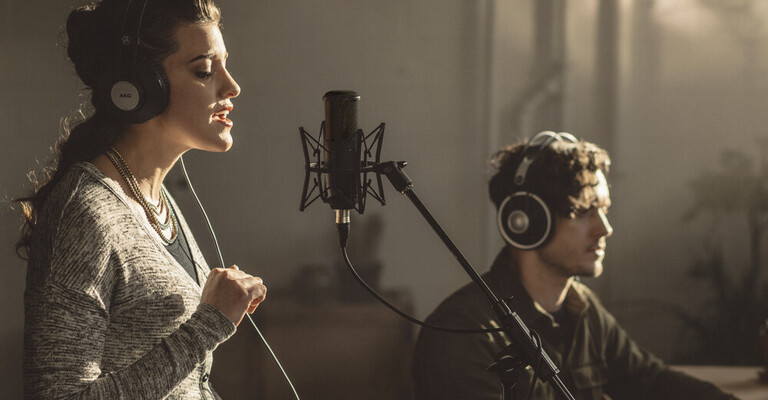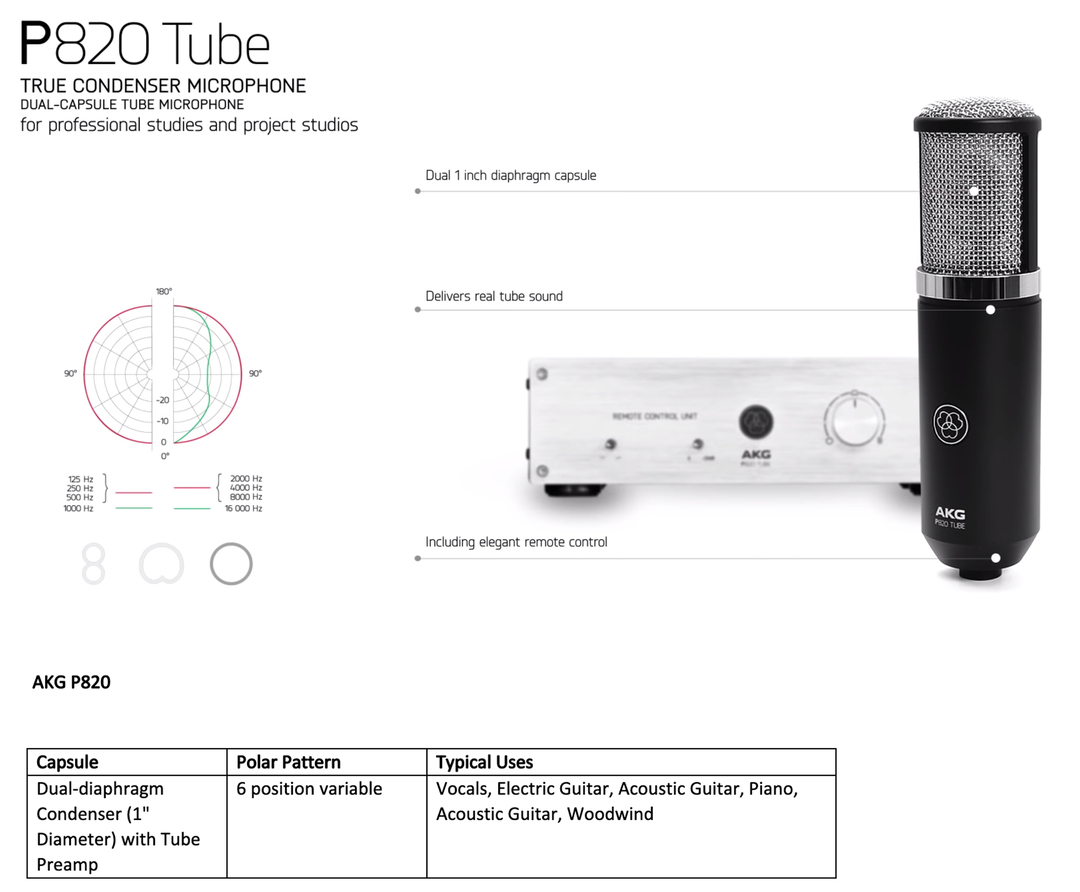
AKG mics and in particular, the AKG C414 is a true studio workhorse that can turn its hand to vocals, drums, pianos, brass, acoustic guitars, choir; you name it, it will sound good through an AKG C414.
But whilst an AKG mic is a must-have tool for any project studio, not all will have the budget for the flagship C414’s. But never fear, for those looking to buy their first AKG mic and be introduced to the AKG sound, there is a whole range of affordable yet powerful microphones available that will get you hooked on AKG.
The Perception range from AKG is a true Austrian-designed microphone manufactured in China under AKG’s watchful eyes. The combination of Austrian design expertise and Chinese production expertise means that the Perception range offers incredible AKG tone with amazing value for money that could not be achievable if the mic was produced elsewhere.
With a wide range of products in the series covering a range of budgets including tube mics, dynamic mics, and small/large diagram condensers, there is a Perception mic available for any application.
In this blog post, we are going to break down each product in the ‘Perception Studio’ range and take a look at what they have to offer and what application they would be most useful for!

The AKG P170 is a small-diaphragm condenser microphone in a traditional ‘pencil’ format that is most suited to instruments rather than vocals. SDCs (Small Diaphragm Condensers) tend to have a more open and pronounced high-end in comparison to Large Diaphragm condensers and are voiced to achieve open and airy sounding recordings.
Small diaphragm condensers can typically seriously loud signals in comparison to LDCs – the P170 is no exception! With 155dB max SPL when the built-in PAD is engaged, the P170 can be positioned near loud instruments without fear of distorting the capsule, making it a candidate for Snare drums or exuberant brass players!
The P170 is designed to be extremely rugged and lightweight thanks to its all-metal body, allowing it to be positioned in more precarious places such as over the top of a drum kit as drum overheads or on busy stages. Not that we would recommend dropping any microphone, the chances of the P170 surviving a great fall is very high!
The P170 has a cardioid polar pattern which means it rejects sound from the rear of the mic but still has a good amount of off-axis response. As the P170 only has a single Diaphragm, its polar pattern cannot be changed unlike other mics in the Perception series, however, a good Cardioid mic covers a massive amount of basis.
If vocals are more your thing, then the P170 may not be perfectly suited for you (although it works amazingly well for vocals ensembles and choirs), but that’s where other mics in the Perception range come in!

The AKG P120 is a back-electret microphone that offers excellent value for money in comparison to the vast LDCs on the market but doesn’t sacrifice sound quality. Perfectly suited for vocals, the P120 is the obvious choice for all vocalists looking to start recording at home or an audio engineer looking for a superb ‘all-rounder’.
The P120 is a Cardioid microphone and so is most sensitive to sounds arriving to its front, while picking up much less of the sounds arriving from the sides or rear. This means the P120 can easily pick up vocals in front of the mic whilst rejecting room noise and other outside influences – perfect for podcasting in less-than-ideal environments!
The P120 features a very smooth high-end in comparison to the P170 which will suit a large range of both female and male voices and there’s also a subtle Low-Cut filter (sometimes called High-Pass) which can be engaged to reduce low-end rumble and resonances on sources with excessive lows.
Unlike the P170, the P120 is a side-address mic which means that you should point the AKG logo on the body of the mic at the source rather than the top of the microphone!

The AKG P220 is a true-condenser microphone with a more traditional 1” capsule that offers a wider frequency response and higher SPL handling than the P120. The extra low-frequency extension and higher sensitivity in comparison to the P120 means that it is slightly more suited to sources with wide-dynamic range and instruments with rich frequency content such as Piano and Orchestral instruments.
Unlike the P120, the P220 comes with its own spider shock mount which allows it to be used without fear of floor rumble and transmission coming through the stand and into the capsule. Given that the P220 has a wider frequency response, this is more of a requirement in comparison to the P120’s naturally curtailed low-end.
Much like the P120, the P220 also has a –20dB switchable attenuator Pad and a Low-Cut (High-Pass) filter albeit with a slightly more aggressive slope (-12dB/Oct rather than –6dB/Oct on the P120) – again, to accommodate for the extra low-end response of the P220’s capsule.

The AKG P420 is the first mic in the Perception range to be multi-pattern. This means that it is capable of exhibiting a Cardioid, Omni, or Figure 8 pickup pattern at the flick of a switch. The P420 achieves this by using its dual-diaphragm capsule to mix, blend, and invert both diaphragms to achieve the different patterns.
Exploiting the characteristics of different Polar patterns is a unique way of manipulating your audio source to capture the elements you want whilst rejecting the elements you do not. A figure 8 polar pattern picks up audio from the front and back of the capsule whilst strongly rejecting the sides whilst an Omnidirectional polar pattern picks up sound evenly all around the capsule. An Omni mic works really well when used as ambience/room mics as when it is positioned in a room, the mic picks up a full representation of the room unlike a Cardioid mic which will only detect what is put in front of it. Figure 8 patterns are also extremely useful in stereo recording techniques such as in a Blumlein pair – but that's a topic for another blog!

The AKG P820 is quite a unique microphone in the Perception range as It’s the only microphone in the range to feature a tube-driven preamplifier to add natural warmth and rich harmonics to the signal. Whereas the other mics in the Perception range have very clean and natural sonic signature, the P820 has a typically ‘vintage’ tube sound which is warm, rich and has a characteristic mid-range presence hump moves the audio source forward in dense mixes and give it a nice edge.
Tube microphones operate slightly differently to traditional condenser microphones as they require mains power to drive the tube preamp and will typically come In two components; the capsule itself housed in a mic-looking housing and a metal box that contains the power supply and variable pattern controls of the microphone. The mic body does not have a traditional 3-pin XLR at the bottom, but instead has a 7 pin Din connector (the cable is included by the way!) that passes the signal of both diaphragms to the base unit which then mixes/influences the two diaphragms to achieve the desired polar patterns.
Unlike the other mics in the range, the P820 has variable Polar pattern (adjusted on the base unit rather than the mic itself) rather than 3 ‘preset’ modes. This allows you to dial in a much more ‘tailored’ polar pattern for your chosen source. The P820 also has various widths of cardioid pattern available such as super and hyper-cardioid patterns that are available to achieve a dead spot around 45 degrees off the rear axis. Other patterns achievable include Omni and Figure 8.
No matter your budget, the Perception studio series of mics are serious contenders for your home studio whether you’re looking for your first microphone or a new microphone to add to your collection. With a huge plethora of tonal options and form factors you could easily record an entire band or ensemble using the Perception Studio and Perception Live (to be covered in another blog) dynamic microphones at a price that you may not thought was possible before.
This new blog is presented by the team at Sound Technology Ltd, a leading distributor of musical instruments and pro audio equipment in the UK and ROI.